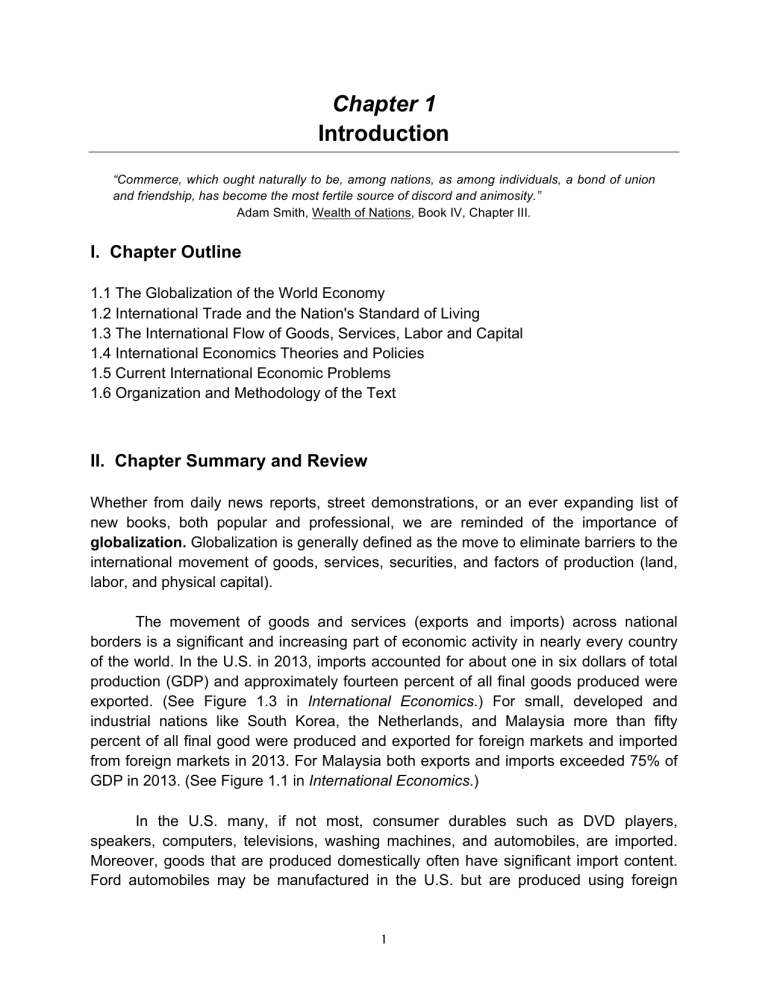
Chapter 1 Introduction “Commerce, which ought naturally to be, among nations, as among individuals, a bond of union and friendship, has become the most fertile source of discord and animosity.” Adam Smith, Wealth of Nations, Book IV, Chapter III. I. Chapter Outline 1.1 The Globalization of the World Economy 1.2 International Trade and the Nation's Standard of Living 1.3 The International Flow of Goods, Services, Labor and Capital 1.4 International Economics Theories and Policies 1.5 Current International Economic Problems 1.6 Organization and Methodology of the Text II. Chapter Summary and Review Whether from daily news reports, street demonstrations, or an ever expanding list of new books, both popular and professional, we are reminded of the importance of globalization. Globalization is generally defined as the move to eliminate barriers to the international movement of goods, services, securities, and factors of production (land, labor, and physical capital). The movement of goods and services (exports and imports) across national borders is a significant and increasing part of economic activity in nearly every country of the world. In the U.S. in 2013, imports accounted for about one in six dollars of total production (GDP) and approximately fourteen percent of all final goods produced were exported. (See Figure 1.3 in International Economics.) For small, developed and industrial nations like South Korea, the Netherlands, and Malaysia more than fifty percent of all final good were produced and exported for foreign markets and imported from foreign markets in 2013. For Malaysia both exports and imports exceeded 75% of GDP in 2013. (See Figure 1.1 in International Economics.) In the U.S. many, if not most, consumer durables such as DVD players, speakers, computers, televisions, washing machines, and automobiles, are imported. Moreover, goods that are produced domestically often have significant import content. Ford automobiles may be manufactured in the U.S. but are produced using foreign 1 International Economics, Twelfth Edition Study Guide steel. Honda automobiles can be manufactured in the U.S. with U.S. labor, but with many foreign parts. The issue of whether a product is domestic or foreign becomes even murkier when considering the issue of ownership for firms whose stock is traded on international markets. Of what nationality is an automobile assembled in the U.S. using foreign made parts, such as Russian steel, when many of the auto company’s stockholders reside in Asia and Europe, as well as in the U.S.? Are the nationalities of goods and services defined by geographical location, the nationalities of the inputs used, the nationalities of the labor that produces the goods and services, or the nationalities of the owners (stockholders) of the firm that produces the goods and services? This international movement of goods, services, and resources affects nations’ standards of living in many ways. Perhaps the most important effect is to increase the standard of living of the average person by lowering the cost of producing goods. With international trade, goods can be produced where they have the lowest cost of production and shipped to where people value them the most. For many forms of interdependence, the volume of activity between nations increases with the size and proximity of trading partners. This relatively simple observation is called the gravity model because of the obvious similarity to the gravitational pull between planets. The form of the gravity model provided by The International Economics text is: 𝑇=𝐶 𝑌! 𝑌! 𝐷 T= the value of trade between Nation 1 and Nation 2, as measured by exports plus imports. Y1=GDP of Nation 1 Y2 = GDP of Nation 2 D = the distance between Nations 1 and 2 C = a constant. This model predicts that we would expect the value of trade in goods and services to be higher between large nations, given geographical distance, and higher with geographically close nations, given the size of the nations. Thus, we would expect more trade in goods and services between neighboring France and Spain than between France and another more distant similarly sized economy. Similarly, we would expect more trade between the large neighboring economies of the U.S. and Canada than between the U.S. and another large but distant economy, like Russia. By the gravity model, trade between the small nation of Kazakhstan and the large distant U.S would 2 Chapter 1 / Introduction be very small. This simple gravity model is borne out by the actual value of the volume of trade (exports plus imports) for the U.S. The largest, nearest trading partner of the U.S. is Canada. The volume of trade between the U.S. and Canada accounts for more of total U.S. trade than any other nation. Other major trading partners of the U.S. are large nations and/or near nations like, in decreasing order of trade volume, China, Mexico, Japan, Germany, and the U.K. With the increased integration of economies comes not only increased shipments of goods and exchange services, but also increased movement of people across national borders. Since 1980 first-generation legal immigrants have accounted for at least twenty percent and as much as sixty-five percent of the year-to-year growth in the U.S. population. The effect of that immigration can be seen among all walks of life, including physicians, taxi drivers, storekeepers, and students. Less apparent than the movement of goods and people, but equally important, are the effects of the movement of financial capital. The interest rates paid by homeowners in the city of Leige in Belgium and the city of Allentown in Pennsylvania are closely related and determined in international markets. If, for example, interest rates increase in Asia, then funds will flow out of Europe and the U.S. towards the higher rate of return on securities in Asia. The reduction in lending in Europe and the U.S. increases the cost of borrowing to new homeowners on both continents. The financial linkages between nations were very apparent in the recent continuing global financial crisis in which mortgage delinquencies and foreclosures in the U.S. led to tougher credit standards around the world. The flow of funds between nations also affects exchange rates on the foreign exchange markets. If funds flow out of the U.S., then the increased supply of the dollar on the foreign exchange market leads dollar depreciation (a cheaper dollar for foreigners), which is equivalent to appreciation (a more expensive foreign currency for U.S. residents). Tourists from the U.S. will find traveling abroad more expensive in dollar terms and so will undertake fewer trips abroad. Foreign tourists will find trips to the U.S. cheaper and so will travel more to the U.S. The dollar’s cheaper value will also have important effects on industry. U.S. exports will increase as foreigners take advantage of the inexpensive dollar by buying U.S goods. The higher cost of foreign currency will decrease U.S. imports from abroad as U.S. citizens buy relatively cheaper U.S. produced goods. In late 2001, China became part of the international trading system under the 3 International Economics, Twelfth Edition Study Guide auspices of the World Trade Organization (WTO), officially adding more than one billion people to the rules-based system by which most nations conduct international trade. In addition to the WTO, there are smaller organizations that promote globalization among its members, such as the North America Free Trade Agreement (NAFTA), the European Union (EU) and APEC (Asia-Pacific Economic Cooperation). These regional trading organizations are continually in the process of reviewing the eligibility of new members. Although it is unlikely to continue its rapid growth, however measured, globalization will probably continue to spread. In recent history, the only two years in which trade declined were in 2001 and 2009. The cause in 2001 was recession in the U.S. following the attack on the World Trade Center in New York City, while the decline in trade in 2009 was caused by the world financial crisis that was as the heart of what is known as the Great Recession (2007-2009). Although globalization has rebounded following the recovery from the global financial crisis, it has yet to reach the peak (in total terms and as a % of GDP) reached in 2007. See Figure 1.4 in the International Economics text. Although globalization may raise the average level of world incomes, the benefits of expanded trade are not without challenge or controversy. Special interest groups and high-unemployment nations attempt to protect themselves from foreign competition, purportedly for the national interest. In addition, the anti-globalization movement challenges expanded trade on the grounds that globalization is responsible for pollution, child labor, and income inequality. These are controversial claims, but it is clear that not all people of each nation have access to the gains from international trade. There can be a significant redistribution of income as a result of globalization. International economics is traditionally divided into international trade theory and international finance. International trade theory is the microeconomics of international transactions. The focus of international trade theory is on why countries trade, the effect of that trade on nations, and on the policies adopted by nations towards trade. Parts One and Two of the text and this study guide address international trade theory and policy. International finance is the study of the balance of payments, foreign exchange markets and the macroeconomics of international transactions. The macroeconomics of international transactions is also known as open-economy macroeconomics. International finance is dealt with in Parts Three and Four of the text and this study guide. III. Questions 1. a) Considering the cost of transportation, what types of goods and services are most 4 Chapter 1 / Introduction likely to be traded internationally, and what types of goods and services are not likely to be traded internationally? b) List some goods that countries both import and export. What could explain imports and exports of the same good? 2. a) As an intellectual exercise, try to imagine how a nation's standard of living would be affected if each nation decided to isolate itself from international trade and become self sufficient. b) Now extend the exercise in part a) to yourself as an individual. How would your standard of living be affected if you were completely self sufficient and using goods that only you produced? 3. a) Which special-interest groups, (e.g. particular industries, consumers, workers, the poor, etc.) might be opposed to policies that promote globalization? b) What special-interest groups might favor globalization? 4. Two nations share a border and the average distance between the commercial centers of the two nations is 200 miles. The GDP of the two nations are Y1 = 300b and Y2 = 700b. a) Calculate the value of exports plus imports between the two nations if C=.1 b) If the GDP of Nation 1 increases by 10%, calculate the percentage change in the value of trade between the two nations. 5. What are some of the major international problems facing the world today? 5






